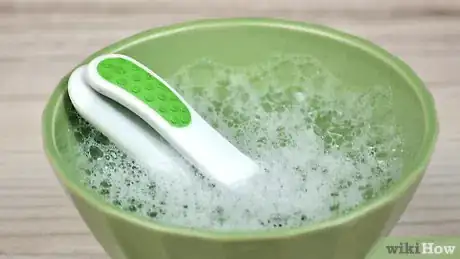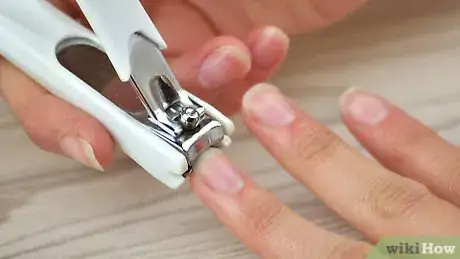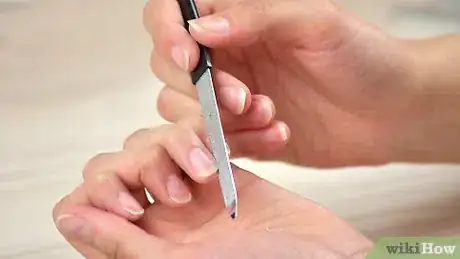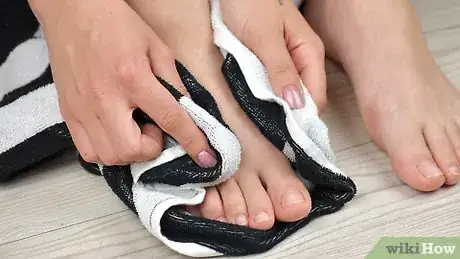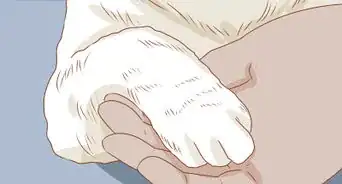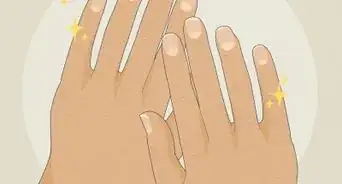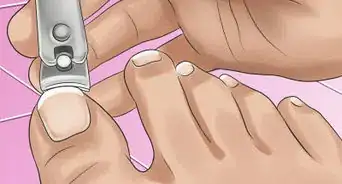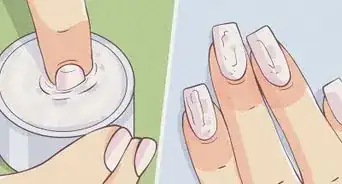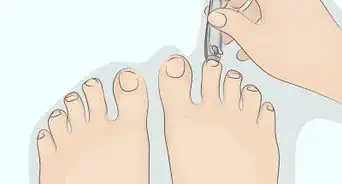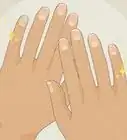This article was co-authored by Marta Nagorska. Marta Nagorska is a Nail Technician and Nail Art Blogger based in London, UK. She runs the blog, Furious Filer, where she gives tutorials on nail care and advanced nail art. She has been practicing nail art for over 5 years and graduated from Northampton College with distinction with a Nail Technician and Manicurist degree in 2017. She has been awarded the top spot in the OPI Nail Art Competition.
There are 8 references cited in this article, which can be found at the bottom of the page.
wikiHow marks an article as reader-approved once it receives enough positive feedback. This article received 16 testimonials and 90% of readers who voted found it helpful, earning it our reader-approved status.
This article has been viewed 1,357,556 times.
It's important to keep your fingernails and toenails trimmed. If they grow too long and too wild, they may become sharp, jagged, and dangerous. You don't need to trim too much – you'll just want to tidy up your nails every few weeks to ensure that they are growing healthily. Read on for tips and techniques that you can use to keep your nails in check.
Steps
Preparing to Cut
-
1Wash your hands and feet. Soak your nails for a few minutes before you cut them – this softens the calcified growths and makes them easier to trim. If your nails are less brittle, you may be less likely to split them. Dry your hands and feet after washing. You can cut your nails while they are wet, but you may have more control over the cut if you are working in a dry environment.
- This step is especially important for toenails. Toenails tend to be thicker and tougher than fingernails, especially on your big toe.
-
2Choose your cutting tool. You can use nail clippers or manicure scissors. The choice is largely a matter of preference. Consider the pros and cons of each option:
- Nail clippers are cheap, simple, and widely available. They cut your nails along a set concave edge – which can be very convenient if the clippers fit your nails, but frustrating if the crescent is too large or too small. Toenail clippers usually feature a heavier bite and a straighter edge to contend with thicker nails and the risk of ingrown toenails.
- Manicure scissors are less common than nail clippers, but some people greatly prefer them. You may need somewhat more finesse to trim your nails with manicure scissors. However, you also have more control over the arc of the cut. As their name suggests, manicure scissors are usually best-suited to hand care. You'll want to use a heavier-duty set of clippers on your feet.
- The U.S. Department of Health and Human Services Health Resources and Services Administration says that it is too dangerous to use other sharp cutting tools—such as knives, razor blades, or regular scissors—to trim your nails. The tool may slip and injure the skin surrounding the nail.
Advertisement -
3Make sure that your clippers are clean. If possible, buy your own set of nail-cutting tools, and keep separate sets for your fingernails and toenails. Wash the implements regularly with a disinfectant for the sake of sanitation. Dish detergent or antibacterial soap will do: just soak the cutting tools for 10 minutes in a bowl of hot, soapy water.[1]
-
4Be mindful of where you cut your nails. Make sure that you set up a place for the clippings to go; you may offend other people if you leave chunks of your nails strewn all over the floor. Consider clipping your nails into a trashcan or a compost bin. Hold your fingers and toes directly over the receptacle, and try to track down the clippings that fly astray. Try not to clip your nails in public spaces, and avoid clipping near people that are talking.
- You can, indeed, compost fingernails and toenails. They won't add much bulk to the pile, but they are organic matter and they will decompose. Don't try to compost fake nails (acrylics) or excessively-polished nails, as these artificial materials will not degrade.[2]
Cutting Nails
-
1Trim your nails often, but do not be overzealous. Nails grow about 1/10 of an inch (2.5 mm) every month, meaning that it takes 3-6 to grow a full nail.[3] If you cut your nails frequently—say, once each week or two—you won't need to worry about them growing too long or too wild. If your nails begin to hurt at the edges, you might be developing an ingrown nail; try to trim away the painful growth before it goes too deep, but it would be wiser to seek a health care professional.
-
2Cut your fingernails. The goal here is to remove the "free edges" of your nails: the opaque, off-white crescents that grow at the tips of your nails. Cut the nails almost completely straight across, and round them a little at the corners to keep the nails strong. Cutting the nail straight will reduce your chance of developing ingrown nails.[4]
- If you are a finger-style guitarist, consider leaving the nails long on your picking hand. Keep at least 1/16th inch (1.5 to 2 mm) of nail on each finger of your picking hand.
-
3Make small cuts. Cut your nails using a lot of small cuts; do not try to snip away the entire "free edge" with a single cut.[5] Toenails are naturally oval-shaped, and a single cut tends to flatten out the oval.[6]
- Try clipping the nail a few times. Start on 1 side, going across the nail to the opposite side.[7]
-
4Cut your toenails. Use the same strategy that you used on your fingernails. Toenails are typically thicker than fingernails, so make sure that you don't use too small a set of clippers. Cut them straight across; cutting back inwards at the edges will increase the likelihood of problems and for diabetics can lead to medical intervention. If you can avoid it, do not use the same set of clippers on your toenails that you used on your fingernails – this way, you'll avoid transmitting bacteria between your feet and your hands.
-
5Be careful not to cut too much. It can be tempting to keep on trimming your nails (for the sake of convenience, aesthetic, or compulsion) even after you've removed the "free edge". If you trim too deeply, however, you will expose the sensitive skin beneath the nail, and you may increase your risk of infection. Try to keep the ends of your nails even with the top of your finger – or remove all but a tiny sliver of the opaque "free edge".[8]
Filing Nails
-
1Consider filing your nails after you cut them. You don't need to file your nails, but the process may help you shape your nails exactly as you want them. Cutting your nails can leave jagged edges – but it is easy to file them uniform. Use a nail file, a pumice stone, or any other hard, textured surface.
- Jagged nails can catch on clothes, socks, and pantyhose. If your nails catch on something, they may tear or break.
- Filing your nails helps give them a smooth shape.[9]
-
2Wait for your nails to dry. Wait for a while until your nails are dry and are no longer soft. Filing wet nails will leave you with jagged, rough nails when they dry, and may also cause your nails to split and crack.
-
3File your nails. Use a nail file to shape your nails, and to make sure the edges of the nail are smooth. Always file gently, in one long stroke, from the side to the center of the nail. Use the coarse, shaping side first if you need to remove more nail. Then, use the finer-grade shaping side to smooth your nails out.
- Your nails should be slightly triangular or ovular, but not pointed. This will keep them from breaking. Nails can weaken if you file too deeply into the corners and sides.
-
4Inspect your work. As you cut or file, periodically check your nails to ensure that they're all the same length and shape. Make sure that they're smooth – jagged or pointy nails may prove painful and inconvenient in everyday life. Keep clipping and filing until your nails are even.
Expert Q&A
-
QuestionHow do you cut your nails like a professional?
 Marta NagorskaMarta Nagorska is a Nail Technician and Nail Art Blogger based in London, UK. She runs the blog, Furious Filer, where she gives tutorials on nail care and advanced nail art. She has been practicing nail art for over 5 years and graduated from Northampton College with distinction with a Nail Technician and Manicurist degree in 2017. She has been awarded the top spot in the OPI Nail Art Competition.
Marta NagorskaMarta Nagorska is a Nail Technician and Nail Art Blogger based in London, UK. She runs the blog, Furious Filer, where she gives tutorials on nail care and advanced nail art. She has been practicing nail art for over 5 years and graduated from Northampton College with distinction with a Nail Technician and Manicurist degree in 2017. She has been awarded the top spot in the OPI Nail Art Competition.
Nail Artist Don't cut the entire nail in 1 go—this will unnecessarily bend and weaken your nail at the sides. Instead, cut each nail multiple times, working from 1 side of the nail to the other.
Don't cut the entire nail in 1 go—this will unnecessarily bend and weaken your nail at the sides. Instead, cut each nail multiple times, working from 1 side of the nail to the other. -
QuestionHow can I grow my nails faster?
 Riley SavastaCommunity AnswerThe real solution to growing nails is time + not breaking your nails. That means no biting or picking your nails. Always keep nail polish on your nails to create an extra layer of protection, especially when your nails are in water because they will get softened. You could apply jojoba oil to your nails to make them sturdy, just apply it around and under your nails three times a day. You could also watch and subscribe to Simply Nailogical. She has very long nails and has a video on growing your nails as long as hers.
Riley SavastaCommunity AnswerThe real solution to growing nails is time + not breaking your nails. That means no biting or picking your nails. Always keep nail polish on your nails to create an extra layer of protection, especially when your nails are in water because they will get softened. You could apply jojoba oil to your nails to make them sturdy, just apply it around and under your nails three times a day. You could also watch and subscribe to Simply Nailogical. She has very long nails and has a video on growing your nails as long as hers. -
QuestionWhat if I made a mistake and I'm bleeding?
 Community AnswerQuickly clean the wound and cover with a band aid. If the bleeding doesn't stop after a few minutes, contact a doctor.
Community AnswerQuickly clean the wound and cover with a band aid. If the bleeding doesn't stop after a few minutes, contact a doctor.
Warnings
- Don't trim "free edges" too much or they will bleed. They are there for a reason: to prevent infection of the nail bed from germs.⧼thumbs_response⧽
- When cutting nails, do not cut too quickly. Check to make sure that you don't cut off any skin, or too much nail.⧼thumbs_response⧽
- Before starting any of these steps, clean all your nail equipment. Just let them soak for 10 minutes in a bowl of hot soapy water.⧼thumbs_response⧽
- Don't bite your nails; it will create ingrown fingernails and toenails.⧼thumbs_response⧽
Things You'll Need
- Sharp, clean fingernail and toenail clippers
- A wastebasket or compost bin for the clippings
- A bowl of water to soak your fingers and toes
- Cuticle remover and conditioner
- A nail file
References
- ↑ https://www.cdc.gov/healthywater/hygiene/hand/nail_hygiene.html
- ↑ http://www.compostthis.co.uk/nail-clippings
- ↑ http://kidshealth.org/kid/htbw/your_nails.html
- ↑ https://www.aad.org/dermatology-a-to-z/health-and-beauty/every-stage-of-life/children/teaching-healthy-nail-care
- ↑ Marta Nagorska. Nail Artist. Expert Interview. 26 May 2021.
- ↑ http://www.nailsmag.com/article/40829/trim-toenails-like-a-pro
- ↑ Marta Nagorska. Nail Artist. Expert Interview. 26 May 2021.
- ↑ http://www.everydayhealth.com/foot-health/toenail-cutting-tips.aspx
- ↑ Marta Nagorska. Nail Artist. Expert Interview. 26 May 2021.
- Videos provided by Beauty Mantra
About This Article
To cut your fingernails and toenails, start by soaking them in water for a few minutes, which will make them softer so they're easier to trim. Then, use nail clippers to cut your nails straight across at the beginning of the opaque, overgrown tips. You may need to make multiple cuts on the same nail to get the whole tip off. Try not to cut past the opaque tips of your nails or you could expose the sensitive skin underneath. To learn how to file your nails after you cut them, scroll down!


